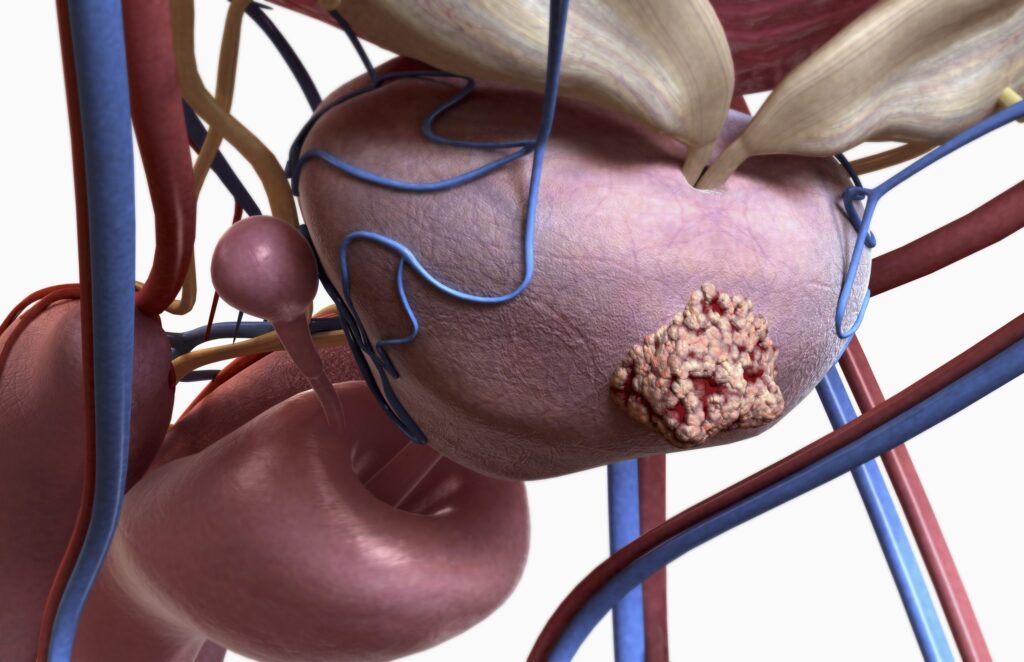A gene expression assay designed to classify prostate cancer into distinct molecular subtypes can, for the first time, be used to identify which patients will respond to hormone therapy when they experience recurrence after radical prostatectomy.
“We’ve been searching for decades for a way to determine which patients are most likely to respond to hormone therapy after prostatectomy,” said Daniel Spratt, MD, principal investigator of the trial and professor and chair of radiation oncology at University Hospitals Seidman Cancer Center and Case Western Reserve University School of Medicine. “We now have a tool that lets us tailor treatment based on a tumor’s biology and recommend hormone therapy only for those patients who we think can expect to see a benefit.”
The test, PAM50, is a gene expression profiling assay originally designed to classify breast cancer into five molecular subtypes based on the expression levels of 50 specific genes. In 2015, Spratt and colleagues adapted the test to make it applicable to prostate cancer.
Spratt explained that the adapted version “captures luminal and basal biology, as well as androgen receptor activity and proliferation pathways.” It has three subtypes: luminal A, luminal B, and basal-like.
Currently, there are no clear tools to help personalize the use of hormone therapy in recurrent prostate cancer, which can affect up to 30% of patients and is often indicated by rising prostate-specific antigen (PSA) levels after prostatectomy.
For patients experiencing an increase in PSA levels after prostatectomy, secondary radiation therapy (SRT), previously termed salvage RT, is the standard treatment. Hormone therapy is commonly added to radiation in this setting to block or lower testosterone, a hormone that contributes to prostate cancer growth.
“We often use a patient’s PSA level and the grade of their tumor to help understand the aggressiveness of the cancer, and the more aggressive it is, the more likely we are to add hormone therapy,” Spratt told Inside Precision Medicine. “However, it is clear we are over treating many patients as not all patients benefit from hormone therapy.”
While hormone therapy can enhance the effects of radiation and improve cancer control for some patients, it also carries a wide range of side effects, including declines in quality of life, fatigue, bone loss, hot flashes, metabolic changes, and cardiovascular risk.
“Testosterone is important for maintaining bone, muscle, cognitive and cardiac health, but it’s also the key fuel driving prostate tumors,” said Spratt. “Until now, we haven’t had a reliable way to tell who really needs hormone therapy and who does not.”
Based on previous findings, Spratt and team hypothesized that patients with different prostate cancer molecular subtypes, as defined by PAM50, would differentially benefit from treatment with apalutamide, a potent oral androgen receptor inhibitor.
To test this hypothesis, they carried out the phase II BALANCE trial, which included 295 patients (median age 65 years) with recurrent prostate cancer and no signs of metastasis. All patients had undergone prostatectomy and were experiencing a rising PSA (86% with entry PSA of <0.5 ng/mL). Of these, 127 had the luminal B subtype and 168 had a non-luminal B subtype according to PAM50.
The participants were randomly assigned to receive SRT with apalutamide 240 mg/day or placebo for six months.
Spratt reported at the American Society for Radiation Oncology Annual Meeting that, after a median five years of follow-up, the risk for biochemical, local, regional, distant recurrence, or death from any cause was a statistically significant and clinically meaningful 45% lower for patients with the luminal B subtype given apalutamide compared with those given placebo. Specifically, the five-year estimated biochemical progression-free survival (bPFS) rates were 72.4% with apalutamide versus 53.9% with placebo.
Importantly, apalutamide showed no benefit in patients with non-luminal B subtypes. In this group, the five-year estimate bPFS was 70.2% versus 71.1% in the apalutamide and placebo arms, respectively.
Metastasis-free survival (MFS) was also significantly improved with apalutamide in luminal B patients but not in non-luminal B patients. For the luminal B group, five-year estimated MSF was 94.7% with apalutamide versus 81.8% with placebo, corresponding to a significant 73% lower risk for metastasis with hormone therapy. In the non-luminal B groups, five-year MFS was 89.9% with apalutamide and 89.3% with placebo.
“This is the first prospective biomarker-driven randomized trial to validate a predictive biomarker in prostate cancer, and it will be practice changing,” Spratt said. “This tool will be used to help guide post-operative hormone therapy use going forward.”
He added that although the BALANCE trial focused on apalutamide, PAM50 could potentially predict response to other hormone therapies, but this will need formal testing.
The researchers are now planning to validate PAM50 in localized prostate cancer and in other disease states of prostate cancer where hormone therapy can be added to radiotherapy.

